Article Contents
- 1 Care and Keeping in Tank
- 2 Feeding Habits
- 3 Hexamitiasis
- 4 Identification and Symptoms
- 5 Deworming Treatment for Flowerhorn
- 6 Tips for Prevention of Parasites in Fish Tank
- 7 Natural Cleansing of the Digestive System
- 8 Maintain a Healthy Digestive System
- 9 Cleanse for Health and Immunity
- 10 Natural Treatment of Fish Parasites
- 11 Natural Anti-Parasite Foods for Fish
- 12 Raw, Crushed Garlic
- 13 Pineapple
- 14 Extra Virgin Coconut Oil
- 15 Vitamin A Rich Diet
Flowerhorn Cichlids are extremely popular ornamental fishes. They are known for their bright and vivid colors and unique shaped heads from which they get their name. They are not naturally occurring fishes and are man-made hybrids developed as a result of cross-breeding of South-American cichlids. Flowerhorns are big fishes with compact bodies. They can grow up to 30 cm and in some cases more than that. The fish breeders are trying to come up with Flowerhorns with a bigger hump on the head, new and brighter colors, wider body and fins, more peculiar marks on the body etc. Flowerhorns were first bred in Asia and have gone on to become very popular worldwide. They have a lifespan of about 10-12 years. Their breeding goes back to 1993.
A well-bred Flowerhorn should be oval and thick shaped. It should have a full belly and stomach. Some of the Flowerhorns also have a more rounded shape. The hump on the head should be big and well proportioned to their body size. The black marks on the body of the Flowerhorns should be thick and well defined. These black marks are one of the principal and most striking features of Flowerhorns. The most common color of Flowerhorns is red but other colors have been developed. It is important that the color should be bright and well defined. The entire body of Flowerhorns should be covered by light blue or green scales. Both the tail and fins of Flowerhorns should be widely spread most of the time.
The male Flowerhorns are larger than the female. Males have a nuchal hump on their foreheads and also have brighter and vivid colors compared to the female Flowerhorns. The mouth of the male is thicker and more pronounced than the female. The female Flowerhorn will lay eggs every month even in the absence of a male.
Care and Keeping in Tank
Due to the big size of Flowerhorns, they need sufficient space for free swimming and being healthy. An adult Flowerhorn needs a minimum of 200 liters capacity fish tank. Flowerhorn is a sturdy fish and can live easily in different water conditions without having any major health problems. However, it is important to provide a water temperature between 25-30-degree Celsius. It should be kept in slightly alkaline water with a pH between 7 to 8. Keeping it in acidic water will affect its color and also provide a breeding ground for parasites. Sudden changes in water and temperature should be avoided as it will make the Flowerhorn more vulnerable to sickness and parasitic attacks. You should also learn how to manage your Flowerhorn aquarium.
Check our selection of tanks that can be good for your flowerhorn :

Flowerhorn being a big fish produces lots of refuses that increase the nitrite and nitrate levels in the water. Hence, an effective filtration system is a must for the fish tank. Either of internal or external filtration systems can be used. The water current in the tank should also be considered. An excessively strong current can damage the Flowerhorn. The water current should be mild as it oxygenates the water and protects against water heating. Tank decorations should be done in the fish tank to make the Flowerhorn feel calmer and quieter. A fine layer of gravel can be used and the rocks and woods should be stable and should not fall on the fish. All the decoration should also not make the cleaning of the fish tank difficult. Live plants should be used in the fish tank as they increase oxygenation. Strong plants like big anubias should be used as Flowerhorns do a lot of digging.
Flowerhorns are big and aggressive fishes and hence they should be preferably kept alone in the fish tank. They should not be housed with other smaller fishes. If more than one Flowerhorn has to be kept then a bigger fish tank should be provided and it should be portioned in the middle to allow the Flowerhorns to stay clear of each other.
Feeding Habits
The diet of Flowerhorns can be a combination of live foods, frozen food, and standard dry fish food. Earthworms and wax worms can be fed to them. Even smaller fishes could be a good feeding choice for the Flowerhorns. When live food is not available, frozen food can be a good alternative. Chironomus, brine shrimps, and other frozen fish foods are preferred by the Flowerhorns. Feeding both live and frozen foods can pollute the water in the fish tank. Hence ensure that the Flowerhorn eats the food in under 5 minutes. If it is not eating then it is recommended to remove the food. Flowerhorns should be fed twice daily. They should be fed in small doses and not be overfed.
Flowerhorn Food
- Okiko
- Grand Sumo Red – Flowerhorn Fish Food – 250 grams
- Omega One Super Color Sinking Cichlid Pellets
- TetraCichlid Cichlid Crisps Advanced
- Fluval Bug Bites Cichlid Fish Food
Check Popular Diseases Affecting Flowerhorn Fish
Hexamitiasis
Hexamitiasis disease occurs in Flowerhorns due to getting infected by Hexamita protozoan parasite. It is a common disease in Flowerhorn fish. It is a highly contagious disease and needs to be treated immediately to prevent it from spreading. It is imperative to keep monitoring the symptoms of hexamitiasis and start the treatment as soon as they become evident. These protozoan parasites are generally found in small traces in the intestines of most aquarium fishes but do not cause any harm. Only when the fish is weakened do these parasites multiply rapidly and spread quickly to the rest of the fish’s body. This spreading of parasites and its establishment in other organs is detrimental to the fish and they can die soon if not provided immediate and effective treatment. Studies suggest that the intestines start producing more mucus as a response to the multiplication of protozoan parasites. This is the main reason behind pale-colored feces which is associated with hexamitiasis. However, the process by which these parasites switch from their normal parasitical form to systemic form which then spreads throughout the body of the fish is still unknown.
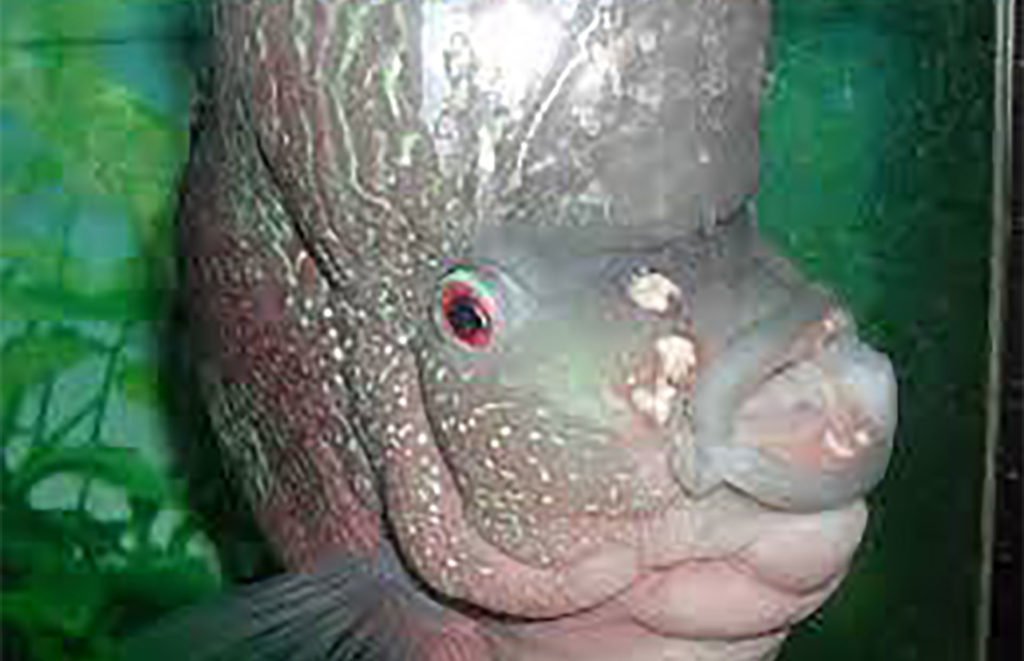
The Hexamita parasites migrate to the sensory pores near the head of Flowerhorn and the lesions cause the nearby tissues to decay. This badly damages the epidermis of the fish, which makes it vulnerable to secondary infections which increase the fatality of the infection. Factors like overstocking, inadequate filtration, insufficient oxygen, lack of regular water changes etc. play an important role in preventing the occurrence of hexamitiasis. Large fishes like Flowerhorn should be kept in sufficiently large water tanks and preferably kept alone. Not doing so and not changing the water regularly will considerably increase the chances of getting attacked by Hexamita protozoan parasite. For Hexamita parasite attacks, nitrate concentration provides a fairly good proxy indicator for the water quality. Nitrate concentration of less than 20 mg/liter should be tried to achieve under ideal conditions. Under worst conditions also, the nitrate concentration should not exceed 50 mg/liter. For maintaining the desired nitrate concentration, it is important to ensure a proper diet to the fish and the amount of nitrate-rich water removed in each water discharge should be minimized. Big fishes like Flowerhorn do not eat every day and they should not be allowed to gorge at every meal. For Flowerhorns, water changes should be regular and constant. Fifty percent per week should be ideal.
It is believed that a vitamin deficient diet weakens the immunity system of Flowerhorns and makes them more vulnerable to Hexamita parasites. A weakened immune system makes Hexamita parasites a bigger problem and it can become fatal for the fish. Flowerhorns should be fed with a vitamin-rich diet. They can get the vitamins from the gut content of their prey/diet. It is also recommended not to use unsafe live foods like cheap feeder fish for the Flowerhorns. Instead, they can be fed a diet of herbivorous invertebrates like earthworms, mussels, snails, river shrimps etc. these diets will ensure the necessary supply of vitamins to the Flowerhorn.
Identification and Symptoms
Flowerhorns infected with Hexamita parasites produce white, stringy feces. The color of the feces becomes more subdued than under normal circumstances. There are lesions that appear on the fish’s head and the tissue near it start to decay. Worms start to crawl out of the head region where the lesions appear. In some cases, the lesions can also start to appear on the flanks of Flowerhorn fish. Hexamita parasite also causes infection in the intestines due to which the fish loses its appetite. They do not eat and become emaciated and if the treatment is not done on time, they are likely to die.
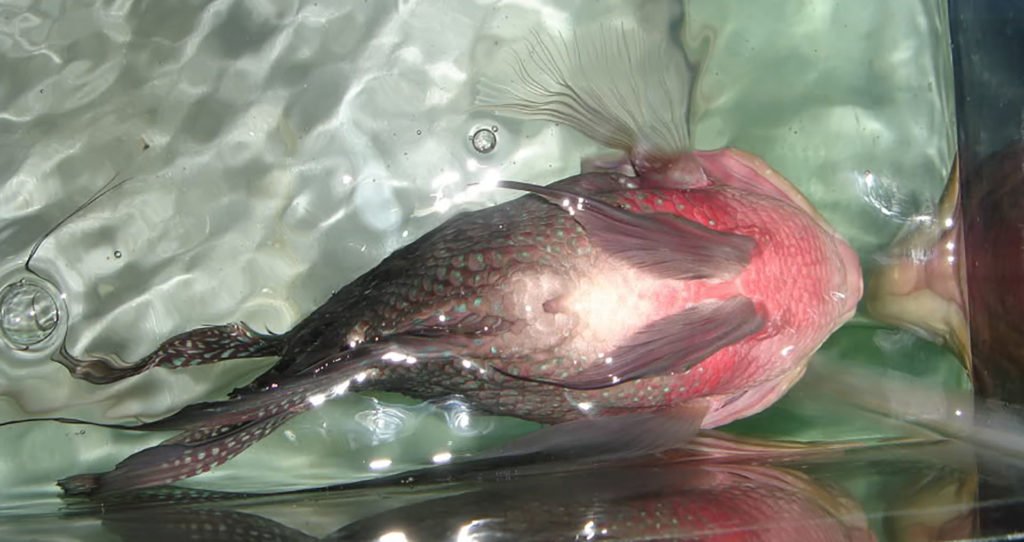
Deworming Treatment for Flowerhorn
When a Flowerhorn is infected by Hexamita protozoan parasite, it is imperative to start the treatment immediately. Flowerhorns infested by the parasite should be dewormed for treating them. The following steps should be followed for deworming treatment for Flowerhorn:
- The deworming should not be carried out in the regular fish tank. It should be done in a larger hospital tank that can accommodate at least 10 gallons of water. The purpose of doing so is to treat the fish in a controlled environment and also the ease of water change that a large hospital tank provides.
- Simple filtration should be added to the hospital tank like a sponge filter or aeration through an air stone. There is no need for heavy filtration as the Flowerhorn will not be fed during the course of the treatment.
- It is recommended to set the temperature of the tank at 32-degree Celsius.
- A half cup of aquarium salt should be added to the tank. If aquarium salt is not available then rock salt without iodine can be used as an alternative.
- Purchase 500mg of metronidazole which is commonly sold over drug counters by the name of Flagyl. This is commonly available and a prescription will not be needed for purchasing it. If it is too costly then its generic drug can also be used for treatment.
- Dissolve 500 mg of metronidazole in warm water. Ensure that the water is warm and not boiling.
- After this, perform 50% water change daily and reintroduce the metronidazole after every water change.
- Replenish about 1/4th cup of salt every day after the water change. Salt helps to increase the osmotic pressure in the water which allows for better absorption of metronidazole through the gills of the fish. It also helps to provide a soothing effect to the natural slime coat of the Flowerhorn fish.
- Make sure that no food is provided to the Flowerhorn during the first five days of the treatment.
- One pellet can be introduced as food from the sixth day onwards. If the fish eats it then it is a good sign that the treatment is producing the intended results. It is important to carry on the full course of treatment even if the Flowerhorn starts eating. The treatment should not be stopped at any cost.
- Keep providing small amounts of food to the Flowerhorn from the sixth day onwards till the tenth day of treatment.
- On the eleventh day of the treatment, perform a 50% water change again.
- Reduce the temperature of the water in the hospital tank to an appropriate temperature in which you would like to keep the fish in regularly.
- The eleventh day is the end of the treatment. Once you are satisfied with the health of the Flowerhorn fish after deworming it, you can shift it back to the main fish tank where it will be kept regularly.

Tips for Prevention of Parasites in Fish Tank
Prevention is the best form of cure. Prevention that strengthens the immune system of the fish and providing a healthy environment for them is the best way to protect them from parasites. Parasites target fishes which are unhealthy and have a weakened immune system due to sickness. Flowerhorn fish should be regularly monitored for any signs of parasite infestation. The treatment should be started at the earliest symptoms which will help to cure them quicker. They should be fed with a high-quality diet and heavily processed food should be avoided. Flowerhorns are large fishes with aggressive behavior, hence they should be kept in a sufficiently large fish tank. Preferably they should be kept alone in the fish tank due to their aggressive nature. The aquarium should be kept clean with regular water changes and should also have a good filtration system. Some of the key tips for preventing parasites in the fish tank and protecting the Flowerhorns form parasitic attacks are discussed below:
Natural Cleansing of the Digestive System
A healthy digestive system is key to tackling parasitic attacks. Fish with healthy and strong digestive systems can counter parasitic attacks without need for active treatment. Parasites thrive on fishes with an unhealthy digestive system. They feast on toxins, high-processed foods, undigested proteins, unnatural mucus etc. A weak and unhealthy digestive system can also hamper the immune system of other organs like the liver and adversely affect their functioning.

Maintain a Healthy Digestive System
Diet is important for ensuring a healthy digestive system in fishes. It is strongly recommended to feed a high-quality and low processed food diet to the fishes. The diet should be based on whole foods which is consistent with the wild feeding habits of the Flowerhorn. Foods that are high in starch, carbohydrates, and sugar should be strictly avoided. Not only are such foods difficult to digest, but parasites also like to feast on such foods. Foods like corn, sweet potato, banana, oranges, etc. should be avoided or fed in very small quantities to the fish.
Cleanse for Health and Immunity
Cleansers can be used for improved health and immunity of the fish. Calcium Montmorillonite Clay (Bentonite) is a proven and effective cleanser. Using it expels the parasites and it also cleans the digestive system of the fish, making it less attractive and inviting for the parasites to attack. Parasites thrive in an acidic environment and the use of Bentonite makes the water more alkaline to counter the parasites. It provides digestible minerals to the fish and soothes the already parasite affected digestive system. Foods high in roughage and fiber like peeled peas, daphnia etc. can also be effective in helping to expel parasites and maintain a healthy digestive system of the fish.
Natural Treatment of Fish Parasites
Single ingredients are rarely effective in killing all the parasites as they can kill only a few types of parasites and their eggs. Hence, the most effective type of parasite treatment combines different ingredients for killing parasites. Gelatin-based anti-parasite food is known to be very effective in expelling parasites from the fish. It also contributes towards strengthening of the immune system which helps to fight against other secondary infections. For Flowerhorns, anti-parasite food can be combined with a nutrient-rich diet which are favorites to them. This increases the palatability of the food and it can be easily digested by Flowerhorns. Anti-parasite food can be fed to the fish for 3 consecutive days per week for 3 weeks for getting the best results. For long-term treatment, it is recommended to anti-parasitic food combined with immunity enhancing food and the food which is Flowerhorn’s wild diet can be fed to them. Many anti-parasite foods are also anti-fungal and anti-bacterial in nature, thereby providing increased protection to the fishes from different types of parasites.
It is important to introduce these foods in small doses to the fish. Fish are small creatures and they should be fed accordingly. Anti-parasite recipes should not be fed regularly over a long time period.
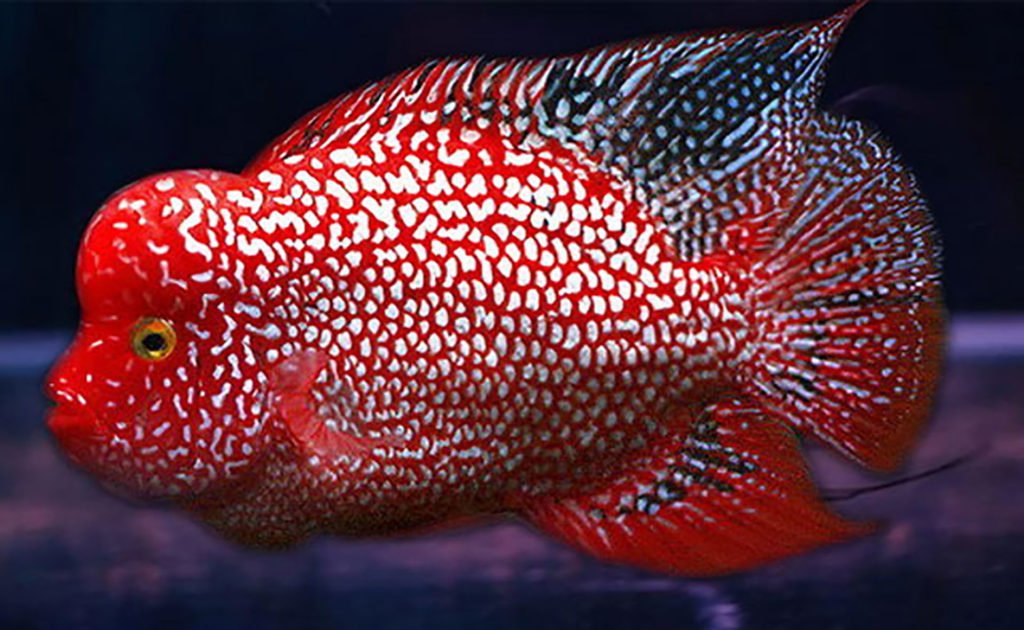
Natural Anti-Parasite Foods for Fish
There are many natural anti-parasite foods that protect the fish from parasitic attacks. Some of the most important natural anti-parasitic foods are as follows:
Raw, Crushed Garlic
Raw and crushed garlic is an effective natural anti-parasitic food. Crushing the garlic activates allicin that is the major component in garlic and is very effective in treating parasites. Allicin is heat-sensitive and thus crushed garlic should not be combined with heat processed fish food as it will be rendered completely useless. Crushed garlic should be fed in very small doses as an overdose will irritate the mucous membranes in the fish and if overfed for too long, it can cause anemia in fishes due to iron-binding.
Pineapple
Pineapples are rich in bromelain- an enzyme that protects from parasites. Feeding pineapples in small therapeutic doses can expel the parasites from the fishes. Other fruits that are rich in bromelain include papaya, pomegranate, and blackberries. These fruits can also be introduced in small quantities in the diet of the fish for protecting them against parasitic attacks.
Extra Virgin Coconut Oil
Extra virgin coconut oil contains a high content of lauric acid which is known to kill parasites.
Vitamin A Rich Diet
Fish can be fed a diet rich in Vitamin A. Foods like raw and dehydrated carrots, pumpkin, and other vegetables high in Vitamin A can be fed to the fish. Vitamin A rich diet is known to increase the immunity of the fish against parasitic attacks. It is important to note that vitamin A rich diet should be fed in small doses. It should be fed to the fish as a part of a balanced diet and high carbohydrate source foods should be avoided.
In addition to the above diet, there are many natural herbs that provide effective protection against parasitic attacks. They are known to kill the parasites and their eggs and soothe the badly damaged digestive system of the fish. Most of these herbs have a strong taste so they should be fed to the fish in small quantities. They can be combined with other more palatable foods for fishes to increase its chances of being eaten by them. In order to be effective, it should be ensured that the herbs being fed to the fish are fresh. Some anti-parasitic herbs such as wormwood are very harsh and may also be dangerous, so they should be avoided.

Keeping and caring for Flowerhorns is much more than only feeding them 2-3 times daily. Maintaining water quality and filtration system in the fish tank is also important. Flowerhorns also have feelings like humans. It is important to keep a close eye on the symptoms of the breakout of the parasitic attack in the Flowerhorns. Over time, our eyes get trained to observe the Flowerhorns and any abnormal behavior can be easily spotted. It is important to take note of these potential parasitic attacks and get the Flowerhorns treated at the earliest. Treatment at an earlier stage of parasitic infestation is much easier to treat successfully.
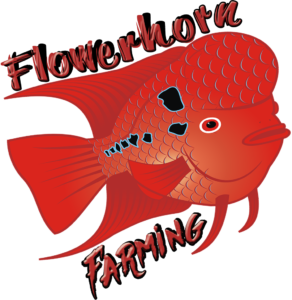
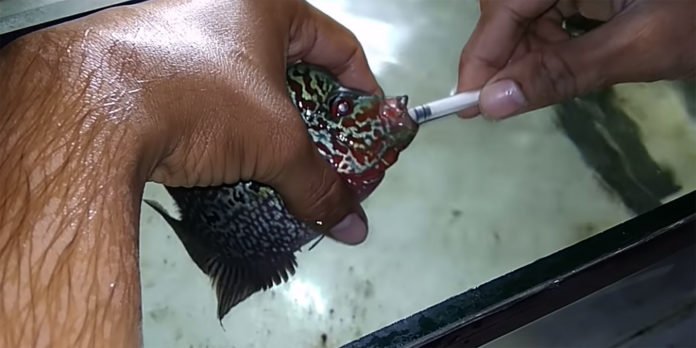



Hi,
I tried above process but still my flowerhorn is not eating food. There is sponge like discharge. He has lost his colour and head. Also developed hole near his nose. Please suggest what can I do to save him.
Can you send us a photo?
Hi salman I am buying a flowerhorn
Check on Ebay
Last month, for the first time my flowerhorn got funny, bumpy white “mushroom-like” stuffs on its fins, cheek, and two spots inside its mouth. It wouldn’t eat for six days straight after decreasing its appetite a few days prior to stopping eating altogether. I kept on changing its water every day (adding new water after taking out a third of the water) and increasing its medicine more and more since I noticed that despite everything I had done, it wasn’t getting better. It just kept sitting on the bottom of a corner and not eating. Several times it would go crazy scratching its face on everything he could– though most frequently it rubbed its face VIOLENTLY onto the filter machine.
I almost gave up and just prayed that when I wake up in the morning, it would still be alive. So I just sat there watching it for quite a long time for the past few days. Then three days ago it started eating again although only a quarter amount of its regular diet. Then two days ago, a third. Today it started eating half of its regular diet. I am still praying.
Just keep controlling the water and filtration. Hope it will get better soon